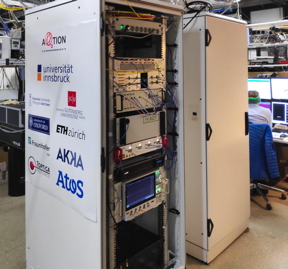Home > Press > Compact quantum computer for server centers: Researchers build smallest quantum computer yet based on industry standards
 |
| The compact quantum computer fits into two 19-inch server racks.
CREDIT University of Innsbruck |
Abstract:
Over the past three decades, fundamental groundwork for building quantum computers has been pioneered at the University of Innsbruck, Austria. As part of the EU Flagship Quantum Technologies, researchers at the Department of Experimental Physics in Innsbruck have now built a demonstrator for a compact ion trap quantum computer. “Our quantum computing experiments usually fill 30- to 50-square-meter laboratories,” says Thomas Monz of the University of Innsbruck. “We were now looking to fit the technologies developed here in Innsbruck into the smallest possible space while meeting standards commonly used in industry.” The new device aims to show that quantum computers will soon be ready for use in data centers. “We were able to show that compactness does not have to come at the expense of functionality,” adds Christian Marciniak from the Innsbruck team.
Compact quantum computer for server centers: Researchers build smallest quantum computer yet based on industry standards
Innsbruck, Austria | Posted on June 18th, 2021
The individual building blocks of the world’s first compact quantum computer had to be significantly reduced in size. For example, the centerpiece of the quantum computer, the ion trap installed in a vacuum chamber, takes up only a fraction of the space previously required. It was provided to the researchers by Alpine Quantum Technologies (AQT), a spin-off of the University of Innsbruck and the Austrian Academy of Sciences which aims to build a commercial quantum computer. Other components were contributed by the Fraunhofer Institute for Applied Optics and Precision Engineering in Jena and laser specialist TOPTICA Photonics in Munich, Germany.
Up to 50 quantum bits
The compact quantum computer can be operated autonomously and will soon be programmable online. A particular challenge was to ensure the stability of the quantum computer. Quantum devices are very sensitive and in the laboratory they are protected from external disturbances with the help of elaborate measures. Amazingly, the Innsbruck team succeeded in applying this quality standard to the compact device as well, thus ensuring safe and uninterrupted operation.
In addition to stability, a decisive factor for the industrial use of a quantum computer is the number of available quantum bits. Thus, in its recent funding campaign, the German government has set the goal of initially building demonstration quantum computers that have 24 fully functional qubits. The Innsbruck quantum physicists have already achieved this goal. They were able to individually control and successfully entangle up to 24 ions with the new device. “By next year, we want to be able to provide a device with up to 50 individually controllable quantum bits,” says Thomas Monz, already looking to the future.
The project is financially supported by the Austrian Science Fund FWF, the Research Funding Agency FFG, the European Union, and the Federation of Austrian Industries Tyrol, among others.
####
For more information, please click here
Contacts:
Thomas Monz
43-512-507-52452
@uniinnsbruck
Copyright © University of Innsbruck
If you have a comment, please Contact us.
Issuers of news releases, not 7th Wave, Inc. or Nanotechnology Now, are solely responsible for the accuracy of the content.
News and information
![]() Atomic-scale tailoring of graphene approaches macroscopic world June 18th, 2021
Atomic-scale tailoring of graphene approaches macroscopic world June 18th, 2021
![]() Changing a 2D material’s symmetry can unlock its promise: Jian Shi Research Group engineers material into promising optoelectronic June 18th, 2021
Changing a 2D material’s symmetry can unlock its promise: Jian Shi Research Group engineers material into promising optoelectronic June 18th, 2021
![]() ‘Nanodecoy’ therapy binds and neutralizes SARS-CoV-2 virus June 18th, 2021
‘Nanodecoy’ therapy binds and neutralizes SARS-CoV-2 virus June 18th, 2021
Possible Futures
![]() Atomic-scale tailoring of graphene approaches macroscopic world June 18th, 2021
Atomic-scale tailoring of graphene approaches macroscopic world June 18th, 2021
![]() Changing a 2D material’s symmetry can unlock its promise: Jian Shi Research Group engineers material into promising optoelectronic June 18th, 2021
Changing a 2D material’s symmetry can unlock its promise: Jian Shi Research Group engineers material into promising optoelectronic June 18th, 2021
![]() ‘Nanodecoy’ therapy binds and neutralizes SARS-CoV-2 virus June 18th, 2021
‘Nanodecoy’ therapy binds and neutralizes SARS-CoV-2 virus June 18th, 2021
Quantum Computing
![]() Researchers realize high-efficiency frequency conversion on integrated photonic chip April 23rd, 2021
Researchers realize high-efficiency frequency conversion on integrated photonic chip April 23rd, 2021
![]() Scientists build the smallest cable containing a spin switch March 12th, 2021
Scientists build the smallest cable containing a spin switch March 12th, 2021
Discoveries
![]() Atomic-scale tailoring of graphene approaches macroscopic world June 18th, 2021
Atomic-scale tailoring of graphene approaches macroscopic world June 18th, 2021
![]() Changing a 2D material’s symmetry can unlock its promise: Jian Shi Research Group engineers material into promising optoelectronic June 18th, 2021
Changing a 2D material’s symmetry can unlock its promise: Jian Shi Research Group engineers material into promising optoelectronic June 18th, 2021
![]() ‘Nanodecoy’ therapy binds and neutralizes SARS-CoV-2 virus June 18th, 2021
‘Nanodecoy’ therapy binds and neutralizes SARS-CoV-2 virus June 18th, 2021
Announcements
![]() Changing a 2D material’s symmetry can unlock its promise: Jian Shi Research Group engineers material into promising optoelectronic June 18th, 2021
Changing a 2D material’s symmetry can unlock its promise: Jian Shi Research Group engineers material into promising optoelectronic June 18th, 2021
![]() ‘Nanodecoy’ therapy binds and neutralizes SARS-CoV-2 virus June 18th, 2021
‘Nanodecoy’ therapy binds and neutralizes SARS-CoV-2 virus June 18th, 2021
Interviews/Book Reviews/Essays/Reports/Podcasts/Journals/White papers/Posters
![]() Changing a 2D material’s symmetry can unlock its promise: Jian Shi Research Group engineers material into promising optoelectronic June 18th, 2021
Changing a 2D material’s symmetry can unlock its promise: Jian Shi Research Group engineers material into promising optoelectronic June 18th, 2021
![]() ‘Nanodecoy’ therapy binds and neutralizes SARS-CoV-2 virus June 18th, 2021
‘Nanodecoy’ therapy binds and neutralizes SARS-CoV-2 virus June 18th, 2021










